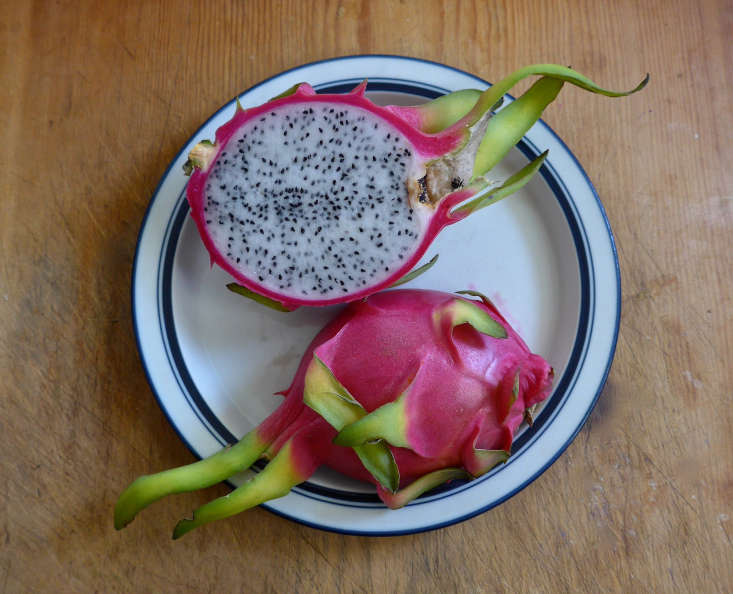Dragon fruit, Hylocereus undatus (Pitaya blanca)
With the new year comes the search for new and interesting plants. I originally heard about this plant, embarrassingly, when my son ordered a vibrant magenta-hued Mango Dragonfruit Refresher from Starbucks. I tasted the cold drink and found it, of course, sweet and tropical, but I fell in love with the color that came from the addition of pink-skinned dragon fruit pieces. Immediately I wondered if I could grow this fruit. After some rudimentary sleuthing, I learned that this plant is a species of tree in the cactus family; it’s a climber; it gifts you footlong fragrant flowers and nutritious edible tropical fruit; and the skin is actually neon pink. I was sold.
Please keep reading to learn more about this strange-looking but curiously cool plant:

Indigenous to South America and warm, humid climates, and cultivated in tropical and subtropical regions, dragon fruit is known by many names, including cactus fruit, strawberry pear, Belle of the night, and moonlight cactus. Based on the common names, you might infer that something perhaps happens in the night—you’d be right. From July through October, each large white fragrant flower only opens for one night and then is withered by the morning. The dragon part of the name refers to the leathery skin and scaly spikes that would make a person think twice about eating it. But of course you can; it’s mildly sweet, has tiny black crunchy kiwi-like seeds, and is in fact nutritious. This tropical fruit contains high levels of vitamin C and carotene, which has anti-cancer properties.

Dragon fruit is a tropical plant through and through, and needs to remain in temperatures about 40 degrees F, with an ideal temperature between 60 and 80 degrees F. In USDA zones 9-11, dragon fruit can perhaps survive outdoors all year. If, however, you live outside of those mild zones, then this plant makes the perfect candidate for a container so that you can move the plant and pot indoors when cold weather sets in. Just remember that a dragon fruit tree needs a large pot , so you may want to consider investing in a dolly or placing your pot on wheels.

Dragon fruit is self-fertile so technically you only need one plant to produce fruit, but more than one will increase the size of your crop. Also, you can propagate this plant with the seeds you collect from the fruit itself. To do this, cut the fruit in half, scoop out the seeds, and wash them to separate them from the flesh. Dry the seeds overnight then place them in potting soil, but close to the top. Moisten the soil, cover it with plastic wrap, keep the soil moist and wait 10 to 15 days for the seeds to germinate. Once they sprout, you can carefully transplant the seedlings to a slightly larger pot. If you are lucky to have a friend with a mother plant, you can politely ask if you can take a cutting. Once you do this, let the end dry out for a few days. Once dry, plant your section about two inches into the soil and keep the soil moist but not soggy. Hopefully in three to four weeks you’ll see new growth, but remember that your plant may take a few years to produce fruit.
Cheat Sheet

- Add dragon fruit to salads and fruit smoothies. The flavor is like a melon mixed with a pear, and the texture is similar to a kiwi. To eat dragon fruit, cut it in half and scoop out the flesh or peel away the skin.
- Harvest when the skin is flaming pink and not any sooner because like strawberries, this fruit doesn’t continue to ripen off the plant.
- With its trunk resembling a palm tree, this plant has an exotic vibe and would look at home in a modern, tropical garden.
- Grow this tropical cactus as a focal plant in a decorative pot with drain holes.
Keep It Alive

- Dragon fruit needs sun to produce fruit so plant it in a full sun spot or a place that gets at least 6 hours of sunlight a day. When situated indoors, make sure your plant is in a warm and sunny spot.
- Unlike most cactus, dragon fruit likes to have its soil on the slightly moist side.
- Plant your dragon fruit in fast draining potting soil formulated for cactuses, or if planted in the ground, make sure your soil is sandy and slightly acidic.
- Dragon fruit is a vining cactus and likes to climb. It can clamber 5 to 10 feet so provide some support with a stake or trellis. And because the plant can get overloaded with fruit, make sure your support system is very sturdy.
- This plant appreciates a low-nitrogen cactus fertilizer every other month during its summer growing season, then when winter comes stop the feedings.
- Be on the lookout for small invaders like aphids and mealybugs, and larger creatures like bats and birds who love the fruit.
For more fruit trees to try in your garden, see:









Have a Question or Comment About This Post?
Join the conversation